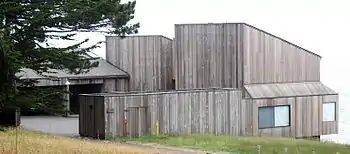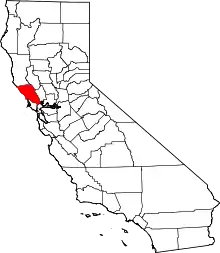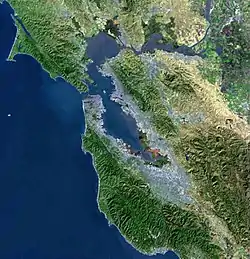Sea Ranch, California
The Sea Ranch is a planned unincorporated community in Sonoma County, California, United States. It is a popular vacation spot. The community's development played a role in the establishment of the California Coastal Commission. The population was 1,305 at the 2010 census.
The Sea Ranch | |
|---|---|
 Panoramic view of The Sea Ranch | |
 The Sea Ranch Location within the state of California  The Sea Ranch The Sea Ranch (the United States) | |
| Coordinates: 38°42′55″N 123°27′16″W | |
| Country | |
| State | |
| County | Sonoma |
| Area | |
| • Total | 16.180 sq mi (41.907 km2) |
| • Land | 16.138 sq mi (41.798 km2) |
| • Water | 0.042 sq mi (0.110 km2) 0.26% |
| Elevation | 108 ft (33 m) |
| Population (2010) | |
| • Total | 1,305 |
| • Density | 81/sq mi (31/km2) |
| Time zone | UTC-8 (PST) |
| • Summer (DST) | UTC-7 (PDT) |
| ZIP code | 95497 |
| Area code(s) | 707 |
| FIPS code | 06-70712 |
| GNIS feature IDs | 1723333, 2583133 |
| Website | www |
History
The first people known to be at The Sea Ranch were Pomos, who gathered kelp and shellfish from the beaches.
In 1846, Ernest Rufus received the Rancho German Mexican land grant, which extended along the coastline from the Gualala River to Ocean Cove. The land was later divided. In the early 1900s, Walter P. Frick bought up the pieces to create Del Mar Ranch, which was leased out for raising sheep. In 1941, the land was sold to Margaret Ohlson and her family.
Architect and planner Al Boeke envisioned a community that would preserve the area's natural beauty.[3][4] Boeke first surveyed the land in 1962.[3] In 1963, Oceanic California Inc., a division of Castle and Cooke Inc., purchased the land from the Ohlsons and assembled a design team.[5] Principal designers who were recruited by Boeke included American architects Charles Moore, Joseph Esherick, William Turnbull Jr., Donlyn Lyndon, Richard Whitaker and landscape architect Lawrence Halprin.[3] Halprin created the master plan for Sea Ranch,[3] which grew to encompass 10 miles (16 km) of the Sonoma County coastline.[3] The principal photographer for the project was the architectural photographer Morley Baer, a friend and colleague of both Turnbull and Halprin. Marion Conrad was hired to manage the public relations for The Sea Ranch.[6] The logo for The Sea Ranch was designed by Barbara Stauffacher Solomon along with the Supergraphics.[7]
Access controversy
The project met opposition that led to notable changes in California law. While the County Board of Supervisors initially regarded the developer's offer to dedicate 140 acres (0.57 km2) for public parkland as sufficient, opponents felt more coastal access was necessary. The site, containing 10 miles (16 km) of shore, had been available to the public but would be reserved for private use under the developer's plan. Areas below high tide were and would remain public property, but the plan provided no access through the development.[8] In addition, California's coast at the time was only open to the public along 100 of its 1,300 miles (2,100 km).[9]
Californians Organized to Acquire Access to State Tidelands (COAST) was formed in response to this issue, and their 1968 county ballot initiative attempted to require the development to include public trails to the tidelands. While the initiative did not pass, the California legislature's Dunlap Act did pass that year and required that new coastal development dedicate trails granting public access to the ocean. This episode led to the establishment of the Coastal Alliance, an organization of 100 groups similar to COAST, that placed Proposition 20 on the statewide 1972 ballot. The initiative passed, and it established the California Coastal Commission, which continues to regulate land use on the California coast.[10]
Geography
The Sea Ranch is located along the Pacific Coast, about 100 mi (160 km) north of San Francisco and 120 mi (190 km) west of Sacramento. The Sea Ranch is reached by way of State Route 1.
About 4 mi (6 km) northwest of The Sea Ranch, in neighboring Mendocino County, is Gualala, a small town.
Climate
According to the Köppen Climate Classification system, Sea Ranch has a warm-summer Mediterranean climate, abbreviated "Csb" on climate maps.
| Climate data for Sea Ranch (1980-2016) | |||||||||||||
|---|---|---|---|---|---|---|---|---|---|---|---|---|---|
| Month | Jan | Feb | Mar | Apr | May | Jun | Jul | Aug | Sep | Oct | Nov | Dec | Year |
| Average high °F (°C) | 56.5 (13.6) |
59.7 (15.4) |
61.5 (16.4) |
64.5 (18.1) |
67.5 (19.7) |
71.0 (21.7) |
73.0 (22.8) |
74.0 (23.3) |
72.8 (22.7) |
68.3 (20.2) |
61.3 (16.3) |
56.0 (13.3) |
65.5 (18.6) |
| Average low °F (°C) | 42.0 (5.6) |
43.7 (6.5) |
45.0 (7.2) |
46.3 (7.9) |
48.8 (9.3) |
50.8 (10.4) |
51.0 (10.6) |
51.0 (10.6) |
50.8 (10.4) |
48.0 (8.9) |
45.7 (7.6) |
42.0 (5.6) |
47.1 (8.4) |
| Average precipitation inches (mm) | 6.5 (170) |
6.4 (160) |
4.73 (120) |
2.2 (56) |
1 (25) |
0.33 (8.4) |
0.05 (1.3) |
0.08 (2.0) |
0.43 (11) |
1.98 (50) |
4.5 (110) |
6.56 (167) |
34.76 (880.7) |
| Average precipitation days | 13 | 10 | 12 | 7 | 4 | 1 | 0 | 1 | 2 | 4 | 10 | 12 | 76 |
| Source 1: weatherspark[11] | |||||||||||||
| Source 2: bestplaces.net[12] | |||||||||||||
Demographics
For statistical purposes, the United States Census Bureau has defined Sea Ranch as a census-designated place (CDP).[13] The census definition of the area may not precisely correspond to the local understanding of the community.
2010
The 2010 United States Census[14] reported that The Sea Ranch had a population of 1,305. The population density was 80.7 people per square mile (31.1/km2). The racial makeup of The Sea Ranch was 1,220 (93.5%) White, 15 (1.1%) African American, 3 (0.2%) Native American, 10 (0.8%) Asian, 0 (0.0%) Pacific Islander, 37 (2.8%) from other races, and 20 (1.5%) from two or more races. Hispanic or Latino of any race were 117 persons (9.0%).
The Census reported that 100% of the population lived in households.
There were 689 households, out of which 58 (8.4%) had children under the age of 18 living in them, 407 (59.1%) were opposite-sex married couples living together, 19 (2.8%) had a female householder with no husband present, 9 (1.3%) had a male householder with no wife present. There were 27 (3.9%) unmarried opposite-sex partnerships, and 21 (3.0%) same-sex married couples or partnerships. 197 households (28.6%) were made up of individuals, and 113 (16.4%) had someone living alone who was 65 years of age or older. The average household size was 1.89. There were 435 families (63.1% of all households); the average family size was 2.25.
The population was spread out, with 105 people (8.0%) under the age of 18, 18 people (1.4%) aged 18 to 24, 92 people (7.0%) aged 25 to 44, 495 people (37.9%) aged 45 to 64, and 595 people (45.6%) who were 65 years of age or older. The median age was 63.7 years. For every 100 females, there were 91.6 males. For every 100 females age 18 and over, there were 90.2 males.
There were 1,818 housing units at an average density of 112.4 per square mile (43.4/km2), of which 85.8% were owner-occupied and 14.2% were occupied by renters. The homeowner vacancy rate was 3.4%; the rental vacancy rate was 38.8%. 81.5% of the population lived in owner-occupied housing units and 18.5% lived in rental housing units.
2000
In 2000, of the residents in the census tabulation, 365 (48.6%) were male and 386 (51.4%) were female. The median age was 61.3 years. Nine residents (1.2%) were aged under five years, 713 residents (94.9%) were aged 18 years or more, and 287 (12.4%) were aged 65 years or more. The census categorized 732 (97.5%) as white, 8 (1.1%) as black or African American, 2 (0.3%) as Asian, and 9 (1.2%) as two or more races. The census counted 13 residents as Hispanic or Latino. The average household size was 1.88, and the average family size was 2.17. The census counted 1,211 housing units, 365 of them owner-occupied, 35 renter-occupied, and 811 (67%) vacant. The median reported household income was $69,327, and the median per capita income was $21,587. There were 25 people (3.3%) living below the poverty line.[15]
Design
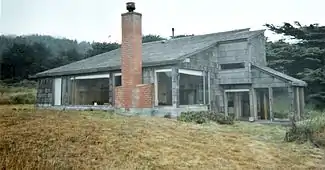

Sea Ranch is noted for its distinctive architecture, which consists of simple timber-frame structures clad in wooden siding or shingles. The building typology of the Sea Ranch draws on the local agricultural buildings for inspiration, in the way that those buildings are designed to deal with prevailing weather and topography. Originally, the Sea Ranch had local lumber mills to draw on for the Douglas Fir and Redwood used in the homes. The majority of the 1800 or so homes currently finished are smaller second homes, though there is about 300 full-time residents. Approximately half the homes are rented as weekend rentals. The eventual build-out will consist of approximately 2400 homes; the number varies as some current owners purchase adjacent vacant lots and merge the two, to preserve open space. The buildings could be considered as a hybrid of modern and vernacular architecture, also known as the "Third Bay Tradition," and also referred to as "Sea Ranch" style.[16]
The original design guidelines suggest that buildings have a site specific relationship with the landscape. The Sea Ranch specific design review requirements include various design guidelines so that the buildings become part of the landscape, not subordinate to it, but do not dominate either.[17] Details such as exteriors of unpainted wood or muted stains, a lack of overhanging eaves, and baffles on exterior lighting subdue the appearance of the buildings in the landscape. Lighting is also baffled to minimize nighttime light pollution; there are no street lights to obscure the night sky. The lack of roof overhangs is also intended to allow the near-constant strong breezes to pass over the buildings without the turbulence the overhangs would create. The Sea Ranch design review process has no impact on the interiors of the buildings, but all construction is subject to Sonoma County Permit and Resource Management oversight.
Landscaping in The Sea Ranch is regulated by a design manual which prohibits perimeter fences and limits non-indigenous plants to screened courtyards.[18] A herd of sheep is used to keep grass cut low to the ground to reduce the threat of fire during the summer months.
Architects
Over the decades many architects have designed houses at Sea Ranch, including:[19]
- Al Boeke
- J. Carson Bowler
- Obie Bowman
- Steve Brodie
- William Scott Ellsworth
- Joseph Esherick
- Nicholas Forell
- John Halley
- Paul Hamilton
- Robert Hartstock
- Donald Jacobs
- Daniel Levin
- Donlyn Lyndon
- Louis McLane
- Charles Moore
- Fiona O'Neill
- Lisa Scott
- Ted Smith
- William Turnbull Jr.
- Dimitri Vedensky
- Ned Westover
- Richard Whitaker
Landscape architects
Points of interest
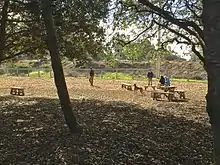
Condominium One (completed in 1965) was awarded the American Institute of Architects Twenty-five Year Award in 1991, and was added to The National Register of Historic Places in 2005.
The Sonoma County Regional Parks Department provides coastal access from six places along State Route 1 in The Sea Ranch area:[20]
- Black Point (trail) at 35035 State Route 1
- Gualala Point Regional Park at 42401 State Route 1
- Pebble Beach (trail) at 36448 State Route 1
- Shell Beach (trail) at 39200 State Route 1
- Stengel Beach (trail) at 37900 State Route 1
- Walk On Beach (trail) at 40101 State Route 1
References
- "2010 Census U.S. Gazetteer Files – Places – California". United States Census Bureau.
- "Sea Ranch". Geographic Names Information System. United States Geological Survey.
- Woo, Elaine (2011-11-20). "Al Boeke dies at 88; 'father' of Northern California's Sea Ranch". Los Angeles Times. Retrieved 2011-12-03.
- Hevesi, Dennis (2011-11-16). "Al Boeke, Architect Who Sought Ecological Harmony, Is Dead at 88". New York Times. Retrieved 2011-12-03.
- Keith, Kelsey (2019-02-20). "'Paradise at the end of the world': An oral history of the Sea Ranch (Part I)". Curbed. Retrieved 2019-02-21.
- Isenberg, Alison (29 August 2017). Designing San Francisco : art, land, and urban renewal in the City by the Bay. Princeton. p. 184. ISBN 9780691172545. OCLC 954134366.
- Poulin, Richard (2012). Graphic Design + Architecture. A 20th-Century History. Rockport Publishers. p. 156.
- Keith, Kelsey (February 21, 2019). "'Paradise at the end of the world': An oral history of the Sea Ranch (Part II)". Curbed. Retrieved 22 February 2019.
- Lyndon, Donlyn (2004). The Sea Ranch. Donald Canty (contributor). Princeton Architectural Press. p. 29. ISBN 1-56898-386-7. Retrieved 2007-12-07.
- "Bluff Top Trail & Public Access Easements In The Sea Ranch Development" (PDF). Sonoma County Regional Parks. 2004-03-05. p. 3. Archived from the original (PDF) on 2007-11-05. Retrieved 2007-12-07.
- "Sea Ranch". Retrieved July 19, 2020.
- "Sea Ranch". Retrieved July 19, 2020.
- "Sea Ranch". Geographic Names Information System. United States Geological Survey.
- "2010 Census Interactive Population Search: CA - The Sea Ranch CDP". U.S. Census Bureau. Archived from the original on July 15, 2014. Retrieved July 12, 2014.
- "Fact Sheet: Zip Code Tabulation Area 95497". Archived from the original on 2020-02-12. Retrieved 2007-12-02.
- Ketcham, Diana (2019-06-11). "A Reality Check for Sea Ranch". The New York Times. ISSN 0362-4331. Retrieved 2019-06-12.
- Iovenko, Chris (2020-10-19). "Discover the Utopian Promise of Sea Ranch, a Unique Community on California's Northern Coast". Fodors Travel Guide. Retrieved 2020-10-26.
- "The Sea Ranch Design Manual and Rules" (PDF). Retrieved 2008-09-19.
- Donlyn Lyndon and Jim Alinder (2004). The Sea Ranch. Princeton Architecture Press. ISBN 1-56898-386-7.
- "Trails Along the Pacific Coast in The Sea Ranch". Sonoma County. Retrieved 2020-11-06.
External links
| Wikimedia Commons has media related to Sea Ranch, California. |
